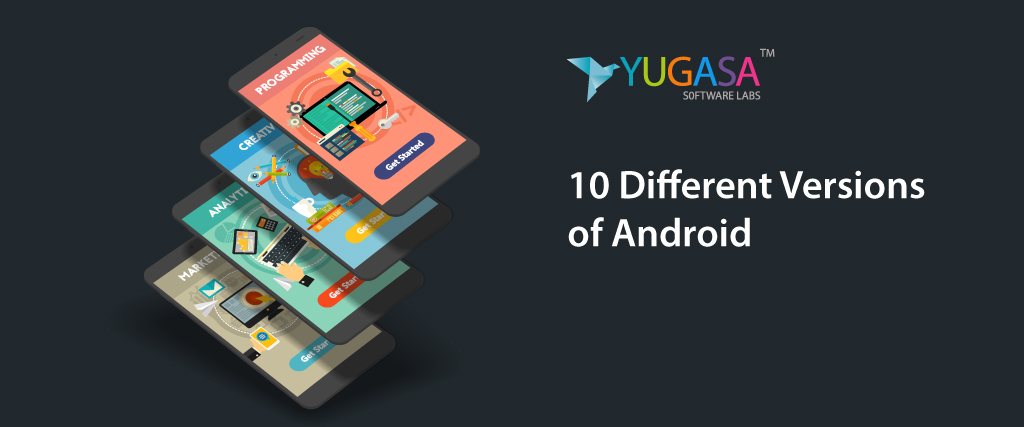10 Different Versions of Android

List of Android Versions: Fun Fact - Did you know Android names are in Alphabetical order! What a long, strange android trip it has been.
Android, a Google product, turned 11 and so the Global rollout of Android 10 begins, here we take a look at all the Android versions and their names.
Here's a fast-paced tour of Android versions from the platform's birth to the present.
1. Android version 1.6: Donut
Android 1.6, Donut, rolled into the world in the year of 2009. Donut assisted some important holes in Android's service, including the ability for the operating system to operating on a variety of different screen sizes and resolutions.
It also supported CDMA networks like Verizon, which would play a key role in Android's immediate expansion.
2. Android version 2.3: Gingerbread
Android's visual identity started coming into focus in the year 2010 with the Gingerbread release. The color bright green became an integral part of the operating system, with the growing fame of the Android mascot.
Black and green seeped all over the user interface as Android started its slow march toward distinguished design.
3. Android 3.0 to 3.2: Honeycomb
The honeycomb period was a weird time for Android. It was launched in the year 2011. Under the guidance of the newly arrived user interface design, Honeycomb introduced a dramatically reimagined UI for Android.
It had a logo-like "holographic" design that traded the platform's patented green for blue and placed an emphasis on making the most of a tablet's screen space.
However, the introduction of a tablet-specific user interface wasn’t very much liked by the users. Although, many of Honeycomb's ideas laid the foundation for the Android we know today.
4. Android versions 4.1 to 4.3: Jelly Bean
In the year 2012, Jelly Bean Android version was introduced. Its release impacted the ICS's fresh foundation and made meaningful changes in re-defining and building upon it.
The releases added plenty of finesse into the operating system and supported a long way in making Android more engaging for the user.
Visuals aside, Jelly Bean introduced the first taste of Google Now to its users.
5. Android versions 5.0 and 5.1: Lollipop
Google purposely reinvented Android Versions. While its Android version 5.0 Lollipop was released in the year 2014.
Lollipop version set standards for material design, which brought a whole new look that extended across all Android and all other Google products.
Lollipop re-defined a slew of new features into Android, including truly hands-free voice control via the "OK, Google" command which supports multiple users on phones and a priority mode.
It was changed for the better but it also introduced a bunch of troubling bugs, many of which wouldn't be fully removed until the next release.
6. Android version 6.0: Marshmallow - List of Android Versions
In the grand scheme of launching new versions, In the year 2015, Marshmallow was a fairly minor Android release. But it started the trend of Google releasing one major Android version per year and that version always receiving its unique number.
Marshmallow's most attractive element was a screen-search feature called “Now On Tap” it was something that had tons of potential that wasn't fully tapped.
Google never quite skilled the system and ended up quietly retiring its brand and moving it out of the forefront the following year.
Android 6.0 introduced some cool stuff with lasting impact.
7. Android versions 7.0 and 7.1: Nougat
In 2016, Android Nougat introduced a native split-screen mode, a data saver feature, and a new bundled-by-app system for organizing notifications. Nougat added some smaller but still crucial features, like an Alt-Tab shortcut for snapping between the apps.
Perhaps most significant of Nougat's enhancements was the launch of the Google Assistant which came alongside the announcement of Google's first fully self-made phone, the Pixel, about two months after Nougat's debut.
The Assistant became a critical component of Android and most other Google products and is the company's foremost effort today.
8. Android version 8.0 and 8.1: Oreo
Android Oreo added multiple cool hacks to the platform, including a native picture-in-picture mode, a notification snoozing option, and notification channels that offer defined control over how apps can notify you.
The 2017 release also included some noteworthy updates that improved Google's goal of aligning Android and Chrome OS.
It was a planned effort to develop a modular base for Android's code to make it easier for device-makers to provide timely software updates.
9. Android version 9: Pie - List of Android Versions
The freshly baked scent of Android Pie, popularly known as Android 9, swiped into the Android ecosystem in August of 2018.
Pie's most thoughtful change was its hybrid button navigation system, which traded Android's traditional Back, Home, and Overview keys for a large, multifunctional Home button and a small Back button that appeared alongside it as needed.
List of Android Versions, Android version 9, commonly known as Pie included some productivity features such as a universal reply suggestion system for messaging notifications and more intelligent systems for power and screen brightness management.
10. Android version 11
The latest, Android 11, launched in September 2020, is a pretty substantial Android update both at the backend and front-end. The version's most significant changes focus on maintaining privacy.
The update defines the expanded permissions system introduced in Android 10 and adds in the ability for users to grant apps certain permissions, those related to location accessibility, camera accessibility, and microphone accessibility.
Read More: TOP 10 ANDROID APP DEVELOPMENT COMPANIES IN GURGAON
